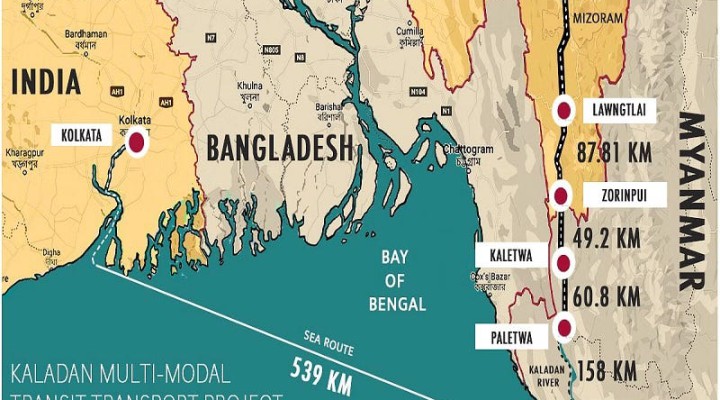India’s Short Connectivity Corridor Through Myanmar Has An Outsized Strategic Importance

Although the Kaladan Corridor’s scope is much smaller than the North-South Transport Corridor and the Vladivostok-Chennai Maritime Corridor, its strategic significance is arguably equal to them if not slightly larger. This assessment is due to the fact that its completion will strengthen India’s sovereignty over its Northeastern States, one of which is the scene of a tense standoff with China that’s driven by its claims to most of Arunachal Pradesh.
India’s rise as a globally significant Great Power over the past year merits more attention to its grand strategy, particularly the connectivity corridors that it’s pioneering across Eurasia. The North-South Transport Corridor (NSTC) and Vladivostok-Chennai Maritime Corridor (VCMC), both of which provide ample opportunities to accelerate de-dollarization by further internationalizing the rupee, are already well known. By contrast, the Kaladan Multimodal Transport Transit Project remains unknown to most.
That’ll likely soon change after the opening of the Indian-funded Sittwe Port in Myanmar on 9 May. Although Delhi’s total investments in the Kaladan Corridor are estimated at a little less than half a billion dollars, this amount is sufficient for streamlining connectivity between its Northeastern States and the rest of the country via that eponymous river per Prime Minister Modi’s “Act East” vision. Locals in that first-mentioned region will then have plenty more socio-economic development opportunities.
Up until now, interstate trade was impeded by bureaucratic problems associated with crossing through Bangladesh and logistical challenges connected with the circuitous Siliguri Corridor, hence the importance of pioneering a much more optimized route between these two parts of India. Although Myanmar is infamous for suffering from the world’s longest-running civil war, which entered a new phase two years ago that continues into the present, the Kaladan Corridor thankfully hasn’t been affected by it.
Although this project’s scope is much smaller than the NSTC and VCMC, its strategic significance is arguably equal to them if not slightly larger. This assessment is due to the fact that the Kaladan Corridor will also strengthen India’s sovereignty over its Northeastern States, one of which is the scene of a tense standoff with China that’s driven by its claims to most of Arunachal Pradesh. Their dispute remains at an impasse, but it’s of the highest priority for India to multidimensionally deter China as Delhi sees it.
To that end, policymakers approved massive infrastructure investments in this part of the country. The purpose of these projects is to show that there’s no question over which state exercises writ over that region, which also explains why India decided to host a G20 event in Arunachal Pradesh in late March. Taken together, these initiatives show that the Northeastern States are an integral part of India, whose people aren’t forgotten by the central government despite their far-flung location.
In fact, that last-mentioned factor is nowadays beneficial for them since it incentivizes India to pay much more attention to this region in the face of China’s recently revived claims there. Furthermore, in the context of the growing Sino-Indo rivalry across Asia, the Kaladan Corridor represents a mutually beneficial initiative that reinforces mutual trust with Delhi amidst Naypyidaw’s drift towards Beijing. This can help prevent Myanmar from becoming the scene of Sino-Indo competition.
Additionally, that struggling country now has tangible proof that India is a reliable development partner, which can help Myanmar diversify its related ties with China in order to preemptively avert any potentially disproportionate dependence on the People’s Republic. The Kaladan Corridor can’t be compared to the much larger China-Myanmar Economic Corridor (CMEC), but the point is that India can expand its investments to obtain more stakes there if Myanmar has the political will for it to do so.
“Reports Indicate That The Sino-Indo Rivalry Is Heating Up In The Bay Of Bengal” so the opening of the Kaladan Corridor’s port of Sittwe in early May can serve to manage the Myanmarese dimension thereof by reinforcing mutual trust between Delhi and Naypyidaw. Coupled with how this project will strengthen India’s sovereignty over its Northeastern States in the context of its border dispute with China there, it’s clear that this short connectivity corridor has an outsized strategic importance.
https://korybko.substack.com/p/indias-short-connectivity-corridor
 TheAltWorld
TheAltWorld 
Rachele Maskell
Hi from DreamProxies.com
Great news: premium, ultra speed and reliable private proxies now even lower prices: 50% DISCOUNT – For All Private Proxies!
Browse proxy coupons and discounts – DREAMPROXIES.COM
Features and advantages that come with each proxy package on DreamProxies.com:
Total privacy – Fully private and anonymous elite proxy servers
Ultimate quality – Highest superior quality and reliability with all proxy packs
Lightning-fast speed – Up to 1,000 mb/s per proxy – fastest speed servers
Endless usage – Unlimited bandwidth and absolute freedom using proxies
Strong Servers – Fully-powered stable US-based datacenter proxy servers
Affordable prices – Among the cheapest proxy services you can find on the market
Additional offers – Exclusive promo codes and offers for proxies on website
50% OFF for all proxy packs – on DreamProxies.com